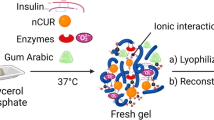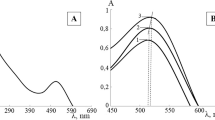Abstract
New basal insulin formulation was designed and their structural characteristics were investigated in vitro and biological activities in type 1 diabetic rats. Zinc-crystallized insulin was physically loaded into hydrophobically modified glycol chitosan (HGC) nanoparticles by a dialysis method. The series of insulin-HGC formulations were prepared with different feed weight ratio of insulin to HGC from 0.5:1 to 4:1. The loading contents of insulin and size distribution of insulin-HGCs were characterized, and blood glucose responses were investigated in streptozotocin-induced diabetic rats after single subcutaneous injection of regular insulin and insulin-HGCs. The highest loading efficiency and content were obtained in insulin-HGC when a 1:1 feed weight ratio of insulin to HGC was employed. The hydrodynamic diameter of insulin-HGC nanoparticles were in the range of 200 to 500 nm with narrow size distribution. Insulin-HGC effectively sustained insulin release up to 40% within 12 hours followed by a slower controlled release. Insulin-HGC showed an extended blood glucose lowering effect up to 24 h and provided normal blood glucose levels after oral glucose (1.5 g/kg) load at 24 hours post-injection while regular insulin showed severe hypoglycemia. The prolonged time action profiles and low variability of insulin-HGC formulation resulted in improved blood glucose control in diabetic rats and fulfilled a pattern desirable of a basal insulin.
Similar content being viewed by others
References
Agu, R. U., Ugwoke, M. I., Armand, M., Kinget, R., and Verbeke, N., The lung as a route for systemic delivery of therapeutic proteins and peptides. Respir Res, 2, 198–209 (2001).
Binder, C., T. Lauritzen, Faber, O., and Pramming, S., Insulin pharmacokinetics. Diabetes Care, 7, 188–199 (1984).
Brange, J. and Volund, A., Insulin analogs with improved pharmacokinetic profiles. Adv Drug Deliv Rev, 35, 307–335 (1999).
Cefalu, W. T., Concept, strategies, and feasibility of noninvasive insulin delivery. Diabetes Care, 27, 239–246 (2004).
Frokjaer, S. and D. E. Otzen, Protein drug stability: a formulation challenge. Nat Rev Drug Discov, 4, 298–306 (2005).
Gershonov, E., Shechter, Y., and Fridkin, M. New concept for long-acting insulin: spontaneous conversion of an inactive modified insulin to the active hormone in circulation: 9-fluorenylmethoxycarbonyl derivative of insulin, Diabetes 48, 1437–1442 (1999).
Hamilton-Wessler, M., Ader, M., Dea, M., Moore, D., Jorgensen, P. N., Markussen, J., and Bergman, R. N., Mechanism of protracted metabolic effects of fatty acid acylated insulin, NN304, in dogs: retention of NN304 by albumin. Diabetologia, 42, 1254–1263 (1999).
Hans, M. L. and Lowman, A. M., Biodegradable nanoparticles for drug delivery and targeting. Current Opinion in Solid State & Materials Science, 6, 319–327 (2002).
Kim, J. H., Kim, Y. S., Kim, S., Park, J. H., Kim, K., Choi, K., Chung, H., Jeong, S. Y., Park, R. W., Kim, I. S., and Kwon, I. C., Hydrophobically modified glycol chitosan nanoparticles as carriers for paclitaxel. J Control Release, 111, 228–234 (2006).
Kwon, S., Park, J. H., Chung, H., Kwon, I. C., and Jeong, S. Y., Physicochemical characteristics of self-assembled nanoparticles based on glycol chitosan bearing 5-cholanic acid. Langmuir, 19(24), 10188–10193 (2003).
McKeage, K. and Goa, K. L. Insulin glargine: a review of its therapeutic use as a long-acting agent for the management of type 1 and 2 diabetes mellitus, Drugs, 61, 1599–1624 (2001).
Owens, D. R., New horizons-alternative routes for insulin therapy. Nat Rev Drug Discov, 1, 529–540 (2002).
Park, J. H., Y. W. Cho, Chung, H., Kwon, I. C., and Jeong, S. Y., Synthesis and characterization of sugar-bearing chitosan derivatives: aqueous solubility and biodegradability. Biomacromolecules, 4, 1087–1091 (2003).
Sinha, V. R., A. K. Singla, Wadhawan, S., Kaushik, R., Kumria, R., Bansal, K., and Dhawan, S., Chitosan microspheres as a potential carrier for drugs. Int J Pharm, 274, 1–33 (2004).
Skyler, J. S. Lessons from studies of insulin pharmacokinetics. Diabetes Care, 9, 666–668 (1986).
Wearley, L. L., Recent progress in protein and peptide delivery by noninvasive routes. Crit Rev Ther Drug Carrier Syst, 8, 331–394 (1991).
Author information
Authors and Affiliations
Corresponding author
Rights and permissions
About this article
Cite this article
Jo, H.G., Min, K.H., Nam, T.H. et al. Prolonged antidiabetic effect of zinc-crystallized insulin loaded glycol chitosan nanoparticles in type 1 diabetic rats. Arch. Pharm. Res. 31, 918–923 (2008). https://doi.org/10.1007/s12272-001-1247-9
Received:
Revised:
Accepted:
Published:
Issue Date:
DOI: https://doi.org/10.1007/s12272-001-1247-9




